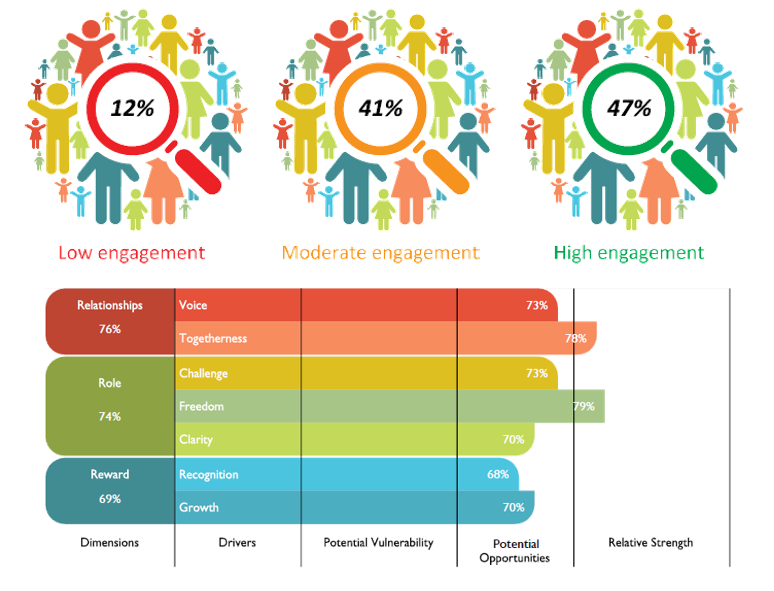We believe the employee engagement dilemma to be so pressing that last month we held a conference, Engage Change, to bring together a host of Heads of Learning, Talent, Engagement and Change to discuss strategies of how to tackle the problem head on. If you doubt the gravity of the issue, then look at these statistics and consider what that means for the world economy in an increasingly digital age. One of the key factors that allows an organisation to remain agile and respond to disruptive technologies whilst still growing is having a high employee engagement rate. Employees themselves, and millennials in particular, cite learning and development opportunities within an organisation as ranking higher than pay in keeping them engaged. So the burden of responsibility falls upon L&D departments to rekindle that engagement. But does this mean sweeping changes within an organisation? Here are 3 key employee engagement misconceptions our conference dispelled.
1. “Employee engagement only represents a problem”
There can be a tendency to expound and exaggerate the negatives when we discuss engagement levels. “40% of all employees are disengaged!” “60% of all employees would rather be asleep than working!” “80% of employees are actively slandering the company and sabotaging its reputation on social media!” Yes, employee engagement is one of the behemoths of business challenges in the current landscape, a beastly burden waiting to be slain. But big beasts guard big treasures, and perhaps we should focus more on the potential rewards that can be gained. Rewards to the tune of an estimated £340m a year in increased productivity. Aside from the bottom line, there are a whole host of more intangible benefits to be reaped for the daring, adventurous organisation, such as improving employee’s wellbeing, happiness and creativity in a symbiotic relationship. This is far from some utopian hippy project, and can be achieved without having to spend any additional funds. On that note…
2. “Change programmes have employees at their core”
There’s no doubting that change is all around us. Indeed, when we polled attendees, the vast majority were either leading or part of a change program:

Driving efficiency through integrated or new systems and internal re-organisations were common uniting factors, mostly prompted by acquisitions or strategic downsizing. What was missing was the people agenda through all of these programmes. Millions had been spent on brand spanking, shiny new systems but the amount of thought and budget for employee engagement and training was minimal. Yet when asked why previous change programmes had either failed or their effect had been diluted, the key reason cited was a lack of employee buy-in or ineffective training.
It’s clear that employee engagement and training and development has to be at the heart of any change management campaign. But effective learning – the kind that changes behaviour and increases performance- the type that inspires people to greater things – has to appeal to the intrinsic motivations of employees. What was shared were some fascinating techniques of how this could be done using behavioural insights, and the measurable results of using these techniques in some actual case studies. These kinds of techniques can be placed into existing or upcoming change or learning programmes at no extra cost, providing the expertise is there.
3. “Employee engagement is intangible and can’t be measured”
Employee engagement is often considered to be a nebulous, ill-defined concept based on how much an employee loves the company, a metric which may be vastly different on either side of the lunchbreak or on different days of the week. The reality is that, though engagement levels aren’t static, they can be broken down into more rigorous categories that aren’t as subject to the whims of hunger or the #FridayFeeling.
Below is an example from Thomas International from their Engage programme, showing engagement metrics:

Investors in People also use surveying methods to gauge employee satisfaction and engagement in the organisations they assess, and at Saffron we know that using analytics within employee platforms can provide even deeper insights, in real time rather than mere snapshots. By breaking down employee engagement levels in this way, it’s possible to define the variables making employees more or less engaged, and this of course means that you can address them far more strategically.
Conclusion
Overall, the conference affirmed that employee engagement is key to any growth or change plan and that L&D have a significant and strategic role to play – a role that puts them and people at the very heart of an organisation’s longevity and its ability to constantly re-invent itself. However, this is only achievable if intrinsic motivations of employees can be addressed clearly and effectively so that employees are transformed, not informed.
For more content from the Engage Change event, including seminars, join the event LinkedIn group.





